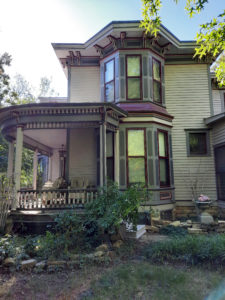Correction: An earlier version of this article gave the wrong date and place for a talk by the authors. They will speak Friday, April 22, at 7 p.m., at the Warkentin House Museum in Newton.
I have read many a book in my day, but I don’t recall ever reading one where the story was told by means of conversations between a mansion and a painting. While the book started slow, I ultimately found “We, the House” to be a charming read, a testament to the creativity and imaginations of the co-authors in combing fact and fiction.

Ambleside, built in Newton in 1878, is narrator and protagonist of a new novel. The book’s authors will speak and sign books at Loraine Avenue Mennonite Church in Wichita at 7 p.m. April 20 and April 22 at 7 p.m. at the Warkentin House Museum in Newton.
The novel’s protagonist is Ambleside, an Italianate mansion built in Newton, Kansas, in 1878 by Henry Luke Hart and his wife, Emmalene Matthews Ridgley Hart. Mr. Hart is a veteran of the Civil War, who comes to Kansas from Joliet, Ill., after recovering from grievous injuries suffered in the war, to make a new life in the Wild West. Hart arrives in Newton in 1873 on the Atchinson, Topeka & Santa Fe Railroad, ending his journey there because it was the first community that the railroad passed through that didn’t already have an iceman. Hart describes his arrival thusly: “When I tumbled out of that train, I had in me possession one eye, two arms, two legs more or less, seven years’ army pension, and five tools: an ice saw, ice tongs, augur, chisel and mallet.”
As co-author Warren Ashworth writers in an author’s note: “Ambleside is a real house. It resides to this day on a small rise in Newton, Kansas. The Harts were my great-grandparents, and all named members of the family are real.” However, he notes, some other characters and “the personalities and characteristics of all the Hart family members are wholly invented by me.”
This book pivots around Newton, which was officially founded in 1872, a year prior to Hart’s arrival. The authors note that the first business to open in town was the Tuttle Saloon and Dance Hall, serving cowboys driving cattle up the Chisholm Trail from Texas. For a brief period of time, Newton had the reputation of the “wickedest town in the west.” That distinction soon moved to Wichita, but that’s another story.
However, as noted above, the stars of the book are Ambleside — the name given by Mrs. Hart to the new home, based on Wordsworth’s ideal village in the English Lake District — and Hermione Sutter Peale, or more precisely, the oil painting of Mrs. Peale that hangs in Ambleside’s dining room. After determining that house and portrait can communicate with each other, Ambleside and Mrs. Peale’s portrait proceed to illuminate the story of Newton, the Harts and their three daughters, and much more. For instance, Mrs. Peale (an honors graduate of the Hartford, Conn., Female Seminary) educates Ambleside about the derivation and meaning of multiple words, such as “Irony: from the Greek eironeia — dissembling — an incongruity between what might be expected and what actually occurs.”
“We, the House” spans a period from the early 1800’s through 2020. There is a lot of engaging, informative history in the book: women’s suffrage; the Great Depression and Dust Bowl; the Spanish Flu pandemic of 1919; World War II and the concentration camps in Germany; and the civilizing of Newton in 1893 with the establishment of Anderson’s Book Store (a store that survives five generations later).
Much is told about Ambleside, from its original construction and electrification to its disrepair, abandonment and finally its loving rehabilitation. It is also a story of life, courtship, love, marriage, hope and death.
Warren Ashworth is an architect who has restored historic homes. Susan Kander, his wife and co-author, first visited Ambleside in 2007. Ashworth also pays tribute in his author’s note to Newton residents Brent and Sheree Rush, who have worked since 1994 to restore Ambleside.
I also look forward to traveling to Newton to visit the actual Ambleside — and Anderson’s Book Store.
Contact Ted Ayres at ted.ayres@shockers.wichita.edu.









